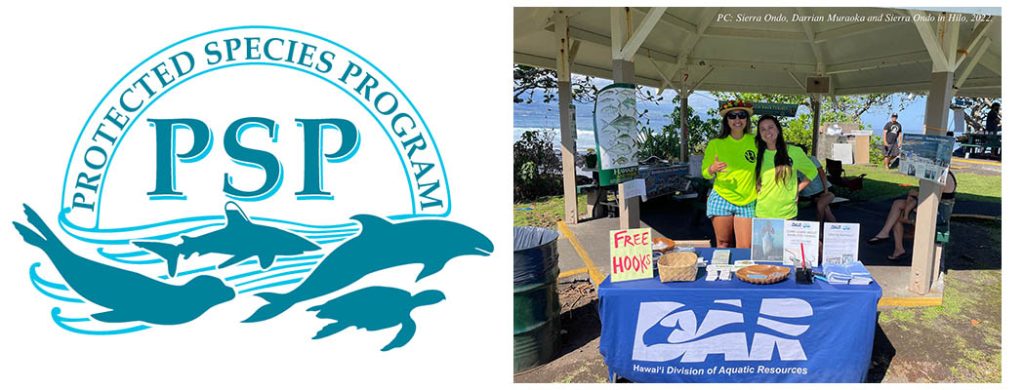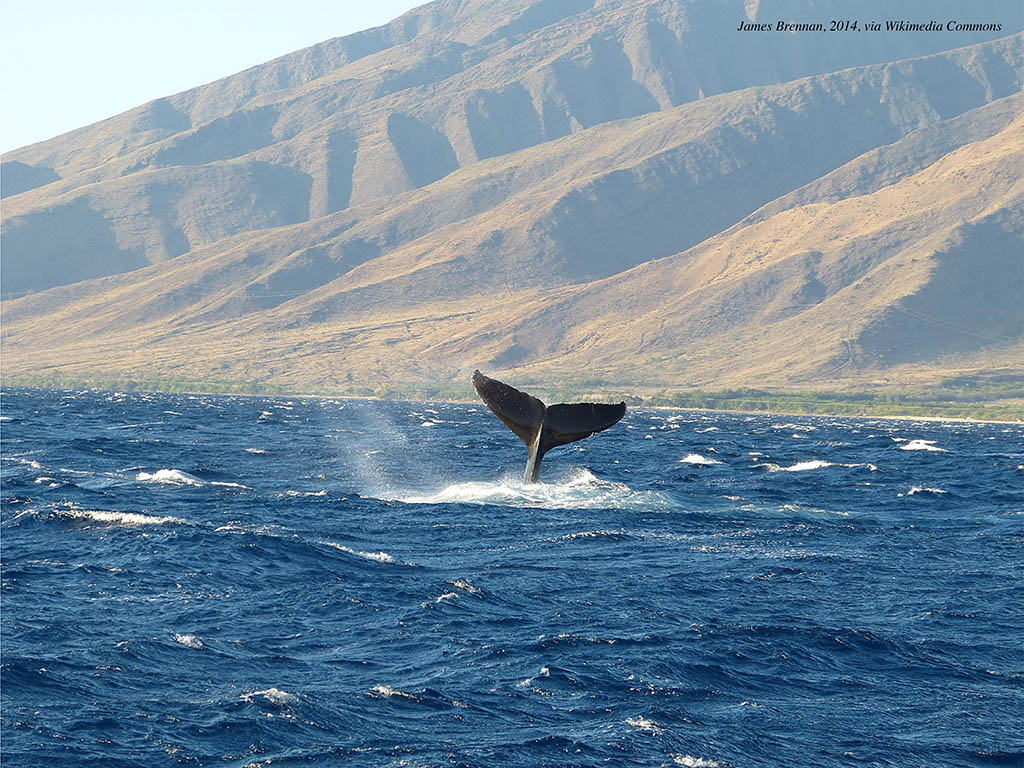Marine Protected Species
What are protected species?
Due to diminishing populations and/or the prospect of extinction, protected species are those that are exempt from harm under various federal or state legislation.
See how you can help protect our marine wildlife. View or download our safe practices and guidelines.

The Protected Species Program (PSP), is a part of the State of Hawai‘i, Department of Land and Natural Resources (DLNR), Division of Aquatic Resources (DAR), and is responsible for conserving, protecting, and enhancing the protected marine animal species found in Hawaiian waters. The PSP does this through public outreach and education, invasive predator management, pono (responsible) fishing advocacy, animal and habitat monitoring, marine debris removal, stranding response, and more.
The IUCN Red List
Each threatened species is listed in the International Union for Conservation of Nature Red List of Threatened Species (IUCN Red List) established in 1964. IUCN Red List categories and criteria were used to create the Red List Index (RLI), which is essentially a list of species that have undergone an extinction assessment. Governmental organizations use the RLI to track species’ progress and make crucial decisions to stop the loss of biodiversity. It displays trends in the total extinction risk for each species.
How does the IUCN Red List Work?
For a species to be added to the IUCN Red List, it must go through an assessment process, after which its extinction risk status is assigned from a selection of eight different categories:
- Extinct –When there is no reasonable doubt that the last individual of a taxon has died.
- Extinct in the Wild – Only present in captive or naturalized populations outside its original range.
- Critically Endangered – Extremely high risk of extinction in the wild.
- Endangered – Very high risk of extinction in the wild.
- Vulnerable – High risk of extinction in the wild.
- Near Threatened – Close to qualifying for a threatened category or is likely to qualify in the near future.
- Least Concern – Low risk of extinction in the wild. Includes widespread and abundant species.
- Data Deficient – Inadequate information for extinction risk assessment.
How are these species protected?
Federal Protections
The Endangered Species Act (ESA) of 1973 is a federal act that provides legal protection and facilitates recovery for the plants and animals listed under it as well as the ecosystems which they rely upon. The United States Fish and Wildlife Service (USFWS) and the National Marine Fisheries Service (NMFS) share responsibility for implementing this act. The Marine Mammal Protection Act (MMPA) of 1972 is another federal act but serves exclusively to protect marine mammal species and monitors the population stocks. USFWS and NMFS share responsibility for implementing this act, while the Marine Mammal Commission (MMC) oversees and councils both federal agencies.
Both of these acts prohibit the “take” of any of the species they protect. “Take” is defined as “to harass, harm, pursue, hunt, shoot, wound, kill, trap, capture, collect, or attempt to engage in any such conduct”. Some of the protected species in Hawai‘i are listed under the ESA, some under the MMPA, and some under both.
State Protections
According to the Hawai‘i Revised Statutes Chapter 195D, the State of Hawai‘i maintains responsibility to protect and conserve native wildlife and their habitats, which includes species federally listed as endangered or threatened under the ESA and MMPA. In other words, the federal protections provided to the species listed under the ESA are adopted by the State of Hawai‘i Law (HRS §195D-4) when the animals are within State management areas. In addition, these animals are also protected by the State of Hawai‘i through the Hawai‘i Administrative Rules 13-124 which serves to conserve, manage, protect, and enhance indigenous wildlife.
The State of Hawai‘i has legal jurisdiction over all main Hawaiian Islands (MHI) land as well as the water surrounding each island out to a distance of three nautical miles. When protected species are within that area, they fall under the State of Hawai‘i management authority.

Resident Marine Mammals
There are 27 species of marine mammals that have been documented in Hawaiian waters. The most famous is the Humpback whale which can only be seen seasonally between the months of roughly November through May. However, Hawai‘i has an abundance of other marine mammals like the false killer whale, spinner dolphin, or the Hawaiian monk seal that can be sighted year-round!
In Hawai‘i, there are three species of marine mammals that are listed as threatened or endangered and protected under the Endangered Species Act. These include the Main Hawaiian Islands insular false killer whale, the sperm whale, and the Hawaiian monk seal. The North Pacific humpback whale population was removed from the endangered species list in 2016 due to their remarkable population rebound.

Marine Mammal Frequently Asked Questions
Q. If I see a marine mammal that’s entangled in rope or net, what should I do?
A. Call the 24-hour NOAA Marine Wildlife Hotline at 1-888-256-9840. If it’s safe, please stay near the animal to keep track of it until a trained response team can arrive. Never try to untangle a marine mammal on your own or without permission and guidance from NOAA. Too many well-meaning people have been seriously injured or drowned while attempting to save an entangled whale, dolphin, or seal.
Q. How close can I get to marine mammals?
A. There are several rules when it comes to viewing marine mammals.
- Humpback whales: Required viewing distance is at least 100 yards away. Federal law prohibits approach within 100 yards, including by boat, kayak, drone, when swimming, or by any other vessel or means.
- Spinner Dolphins: Federal law prohibits swimming with, approaching, or remaining within 50 yards of spinner dolphins in Hawai‘i.
- Hawaiian Monk Seals: Recommended viewing distance: At least 50 feet (15 meters) away—on land and in water. Take special care when around mothers and pups, for your own safety do not swim near the mother and pup. View mother seals and their pups from at least 150 feet (about 45 meters) away and stay behind any signs or barriers.
The recommended viewing distance for all other dolphins and small whales (including false killer whales) is at least 50 yards (45 meters) away. Getting close to these animals may constitute a federal or state violation if the animal is disturbed or if your action has the potential to disturb its natural behavioral patterns. NOAA and DLNR recommend, for your safety and the animals’ protection, that everyone stay at least 50 feet from all marine mammals. If maintaining this distance isn’t possible, keep safety in mind and move away from the animal as carefully as possible, avoiding sudden movements and other actions that might disturb the animal. For wildlife viewers, please enjoy from a distance – use binoculars and telephoto lenses to get the best views without disturbing the wildlife.
Q. Can I film marine mammals with a drone?
A. You must adhere to the NOAA federal guidelines:
The noise and the close proximity of drones can disturb marine wildlife. When viewing marine mammals from the air using a drone:
- Maintain a 1,000-foot minimum altitude when viewing marine mammals from the air in manned aircraft (e.g., helicopters, airplanes). Federal law requires aircraft to fly no lower than 1,000 feet above humpback whales in Hawai‘i and 1,500 feet above North Atlantic right whales throughout U.S. waters.
- Avoid buzzing, hovering, landing, taking off, or taxiing near marine mammals (on land or in the water), as these actions may alter animal behavior.
- Avoid flying drones, or unmanned aircraft systems (UAS), near animals. The noise and the close proximity of drones can harass the animals and cause stress.
A note on drone/UAS guidance: NOAA Fisheries is currently developing national guidance for drone (or UAS) operations targeting marine mammals and sea turtles. Until then, NOAA Fisheries reminds the public that dolphins, whales, and seals are protected species, and harming or disturbing them can be a violation of federal law.
It is important to remember that the Federal Aviation Administration provides rules for drone operation. In addition, the U.S. National Park Service has prohibited the use of drones in many National Parks, some of which provide habitat to marine mammals.
Researchers may use drones/UAS to conduct scientific research on protected species only if the proper permits and authorizations are secured. Learn more about research permitting.


